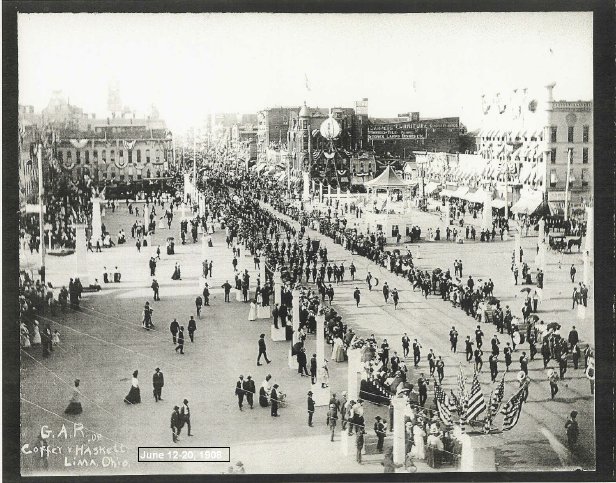
The Grand Army of the Republic (GAR) was an organization comprised of honorably discharged Union Civil War veterans who had fought in the U.S. Army, Navy and Marines. The group was founded in 1866 initially to support veterans and their families as well as being a means for veterans to keep in touch with their comrades after the war. Yet as their numbers grew so did their power and political clout. By the 1890s membership was close to half a million men and the GAR’s influence helped elect notable Republican Union Civil War veterans like U.S. Grant, Rutherford B. Hayes and James Garfield to the U. S. presidency.
More important than its political power the GAR worked to secure federal pensions for veterans, they established soldiers’ homes and did other relief work for the benefit of their membership. They promoted patriotism participating in parades and wreath laying ceremonies to honor fallen veterans. In fact it was the GAR’s National Commander-In-Chief General John Logan who established the first Decoration Day, or Memorial Day as we now know it. A day was set aside to honor the Civil War’s fallen Union soldiers by placing wreaths and flowers on their graves.
GAR members met locally and that group was referred to as a post. Most small towns and villages had a post with larger metropolitan areas having more than one. Ohio alone had 745 organizations. Posts were named after Civil War soldiers who had passed on, many times honoring a soldier who had died in battle. The local posts belonged to their state “Department”, such as the Ohio Department or Iowa Department, and both the posts and departments fell under the umbrella of the national organization.
The national and departments held yearly conventions or “encampments”. The encampments generally spanned several days and included business meetings, memorial services, dinners, fellowship as well as “camping out.”
GAR membership was an important part of a veteran’s life. Through this very powerful group a former soldier was cared for both physically and emotionally as he socialized with other soldiers who had similar war experiences.
A veteran who wanted to join his local post was required to fill out an application for membership. This would include his current vital information as well as his military experience. Once accepted the new member’s information was logged in a Post Descriptive Book. Some posts even had a Memorial Book. Each member had a page in the Memorial Book where personal background information was recorded and even his memories of his military service. The info might include mentions of the veteran’s friends in his regiment and his obituary after his death. Of course there would be Minute Books in each post which would include lots of names and information regarding the activities of the post.
I found the Memorial Book for one of the local GAR posts in the museum of my home town. Called Personal War Sketches this huge, oversized book was engraved for Mart Armstrong Post No. 202. Inside were beautifully illustrated pages where members, in their own hand, wrote where and when they were born, where and when they enlisted. What battles they fought in, how and where they were injured, even what hospital they recovered at. Some sketches included names of friends they fought alongside or a particular event they chose to remember. This book is a goldmine of information and written in the member’s own hand!
Of course as Union veterans died so did the strength and numbers of the GAR. The last member passed away in 1956 and the GAR no longer existed. The records and minutes of individual posts were many times donated to local museums, libraries and historical societies.
By now you can see the records of a GAR Post would be very helpful as you research your Civil War ancestor.
A few places to research the GAR is at this Library of Congress page. It lists posts by locale and state. http://www.loc.gov/rr/main/gar/
Then there is the Grand Army of the Republic Library and Museum. It’s located in Philadelphia and its holdings contain the records of many posts nationwide. http://garmuslib.org/
FamilySearch.org has a few GAR links on their site https://www.familysearch.org/learn/wiki/en/Union_Veterans%27_and_Lineage_Society_Records#The_Grand_Army_of_the_Republic_.28GAR.29.
Ancestry.com has a couple links for Kansas GAR posts.
If you live in the area the New England Civil War Museum might be an excellent place to research. Their library originated with GAR Burpee Post 71. This GAR post started it’s own reading room and library for the members and has now grown in to the New England Civil War Museum.
https://www.newenglandcivilwarmuseum.com/civil-war-research
McLean County Museum of History in Bloomington, IL has a GAR collection of the McCullough and Hovey, and Sherman Posts.
https://mchistory.org/research/finding-aids/collection/grand-army-of-the-republic-gar
Wisconsin Veterans Museum has a substantial GAR collection.
There’s also the GAR and Civil War Museum in Marblehead, MA.
New York State Archives
http://www.archives.nysed.gov/research/res_tips_010_gar.shtml
At Google Books you’ll find the – Records of Members of the Grand Army of the Republic: With a Complete Account of the Twentieth National Encampment … A History of the Growth, Usefulness, and Important Events of The Grand Army of the Republic, from Its Origin to thePresentTime. http://books.google.com/books/about/Records_of_Members_of_the_Grand_Army_of.html?id=0WOAAAAAIAAJ
Most importantly try your local museums, libraries, universities and historical societies to see if they have a GAR collection. My own museum’s library has a GAR collection for another area town as well as the War Sketches Book for the post in my city but none of this was readily accessible. I would never have known it existed if I hadn’t asked.
As you continue your research of your Civil War ancestor I hope this GAR information provides you with some new ideas and additional resources. Good Luck in your research!

